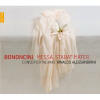Texte paru dans: / Appeared in:
*

Opera News: (01/2013)
Pour
s'abonner / Subscription information
Naïve
OP30537

0709861305377 (ID247)
Consultez toutes les évaluations recensées pour ce cd
~~~~ Reach all the evaluations located for this CD
Reviewer: STEPHEN
FRANCIS VASTA
The Messa a Cinque Concertata of Antonio Maria Bononcini (1677–1726), here
receiving its world-premiere recording, stands out from the general run of
Baroque masses and cantatas. The division of the chorus into five parts,
including first and second sopranos, produces rich textures, though one
wonders whether it made it difficult to maintain the integrity of the
part-writing. (Think of the contrapuntal contortions of Bach's Magnificat.)
The fugal passages overlap musical motifs and bits of text until the parts
converge in glorious unity in homophonic cadences. There are no arias: the
soloists sing in various permutations, either alternating with the chorus or
in self-contained ensembles.
The composer also has a fresh take on the texts. In the three-movement Kyrie, two forthright, active duple-time movements bracket a grave "Christe" in triple time, reversing not only the usual sequence of moods but the conventional associations of moods and their respective meters. Pairs of duetting soloists lead off the Gloria, with the chorus joining later; after the lively opening, the Largo setting of "Et in terra pax" is mysterious, even ambivalent. In the Agnus Dei, the fullest choral textures register as heartrending pleas.
The present performance, recorded in concert at the Wiener Konzerthaus, is first-rate. The quick movements boast sprightly rhythmic address, while the slower ones are spacious and flowing. Like the composer, conductor Rinaldo Alessandrini has a few novel ideas, as when he launches the Gloria without a pause, attacca, from the Kyrie. The blend within the choral sections, particularly among the men, is excellent; the counterpoint is consistently clear and easy to "hear through." The two cellos and single double-bass produce a burnished, resonant foundation for the string orchestra.
The soloists are good. The sopranos, Raffaella Milanesi and Silvia Frigato, sing straightforwardly in clear, vibrant tones. Salvo Vitale's bass moves stiffly, especially in upward leaps, but it provides a firm grounding for the vocal ensembles. The two tenors are unusually well-matched in "Domine Deus," though one of them has shallow "ah" vowels. The various altos also blend well together but may generate some aural confusion: Sara Mingardo's straight-toned adjustment, while gratifyingly solid, makes her sound more countertenorish than Andrea Arrivabene, the actual countertenor! When she lets up on the intensity, she sounds more recognizably female, but the lower voice becomes diffuse.
The sparer textures of the Stabat Mater, also recorded in performance, leave a more austere impression. Again, alert rhythm enlivens the music: note the chorus and orchestra's springy dotted figures in "Virgo virginum praeclara." This score does include arias, and Milanesi gets a chance to shine in "O quam tristis," particularly in a moderately paced, evenly executed melisma. Valerio Contaldo's tenor in "Fac ut portem" is spirited but can be throaty at the top. Mingardo and Vitale sound much as before, to good effect.
For concert recordings, these contain surprisingly few glitches. There's one wayward theorbo plunk near the end of the Benedictus solos in the Mass; in the Stabat Mater, the first entrance in "Fac me plagis" seems to catch Mingardo off guard. The sound is lovely, its subtle, enhancing ambience only becoming noticeable when the choral sopranos venture upwards. The packaging and booklet are generous, though the notes don't explain the nature or extent of the credited "transcriptions" — by the conductor and Massimiliano Pollio — of the two scores.
Cliquez l'un ou l'autre
bouton pour découvrir bien d'autres critiques de CD
Click either button for many other reviews


